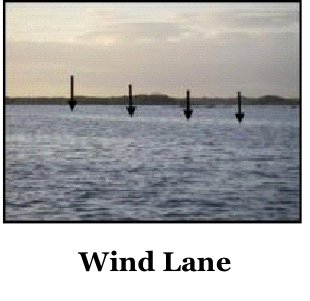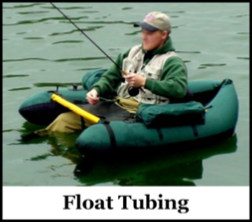BOAT FISHING
BACK TO TABLE OF CONTENTS
BOAT FISHING INDEX
BACK-DRIFTING
 If you feel like a lazier way to pass the time then a spot of back-drifting may fit the bill. This technique involves the boat drifting in much the same way as loch style fishing. However, there the similarity ends. No drogue is used, and instead of continually casting the flies out in front of the boat, we allow them to be dragged behind the boat. We sit facing the direction from which the boat has come - that is, with the direction of travel at our back. It stands to reason that if we just sit there eventually the fly will sink to the bottom of the lake and be dragged along the bottom. To stop the fly getting caught up in the bottom detritus a buoyant fly is used, normally a booby.
If you feel like a lazier way to pass the time then a spot of back-drifting may fit the bill. This technique involves the boat drifting in much the same way as loch style fishing. However, there the similarity ends. No drogue is used, and instead of continually casting the flies out in front of the boat, we allow them to be dragged behind the boat. We sit facing the direction from which the boat has come - that is, with the direction of travel at our back. It stands to reason that if we just sit there eventually the fly will sink to the bottom of the lake and be dragged along the bottom. To stop the fly getting caught up in the bottom detritus a buoyant fly is used, normally a booby.
Once you have the boat upwind and ready to start a drift, simply flick out your fly on a fast sink line into the water you are leaving behind. The fast sink line will submerge, taking the fly with it. Keep pulling line off the reel and allow it to pay out as you drift downwind until you judge that there is sufficient line in the water to allow the line and fly to sink to the bottom. This is more than you would initially expect, as the line will form an angle of about 45 degrees as it comes up from the depths. Then you just sit back and take it easy! Just don't let go of the rod or you might see it pulled overboard before you have time to react.. You should have a look at the additional suggestions and information in the Chapter on Lines.
Another method of back drifting is to use an intermediate line and just pay out sufficient line to get the flies down in the water - how much depends on the depth of water you are in but I would suggest that getting the flies down about five or ten feet or so can be sufficient. That probably means paying out about twenty yards as the motion of the boat will keep an intermediate line quite high in the water. Using an intermediate line - which is less dense than a hi-d allows a gentle angle of line from the rod tip to the fly rather than just hanging straight down as would happen with the extra weight of a fast sink line. Use a team of three flies and you should try putting something like a zonker or minkie on the point. The fur of these flies wave very invitingly as they are slowly pulled through the water and I have had good success using this system during the hot days of summer when no-one else seems to be able to get a bite!
LOOK FOR THE WIND LANES
When the wind gets the water moving, you may have noticed that some areas seem to be rougher than others. This is caused by the mechanics of the waves - in some areas they join together to cause bigger waves and in some areas they cancel each other out. This means that there are areas in the water where there are noticeable calms and they tend to form long thin stretches that run down the wind. They are called wind lanes and can be a fly fisherman's friend when fishing on the drift.
 Because of the motion of the waves anything floating on the surface tends to get gathered into these wind lanes - and that will include any flies and other goodies that the fish eat. You just know that the trout will be well aware of this readymade larder. They will cruise up and down these wind lanes picking off the tasty morsels that have been deposited there for them. So it stands to reason that this is an excellent place to fish if you can spot the wind lane and get your boat to drift down it. That takes a little practice and sometimes means resetting the drogue to get the boat drifting at just the right angle - sometimes these wind lanes form at slight angles to the wind. Use a G-clamp to secure the drogue to the gunwale and keep adjusting it until the boat is drifting at the right angle. Once you've got it right you can get on catching those fish which will be sitting just under the surface. Keep a low profile and avoid standing - which you shouldn't be doing in a moving boat anyway - or the fish will see you coming! A keen eye will detect these fish as they sip their way up the wind lane. With experience you can lay your fly on the water just in time to set up an ambush for the fish. It's great fun to see the fish coming and watch it take your fly! A drowned daddy or similar fly is ideal - this is just what the trout will be expecting to find.
Because of the motion of the waves anything floating on the surface tends to get gathered into these wind lanes - and that will include any flies and other goodies that the fish eat. You just know that the trout will be well aware of this readymade larder. They will cruise up and down these wind lanes picking off the tasty morsels that have been deposited there for them. So it stands to reason that this is an excellent place to fish if you can spot the wind lane and get your boat to drift down it. That takes a little practice and sometimes means resetting the drogue to get the boat drifting at just the right angle - sometimes these wind lanes form at slight angles to the wind. Use a G-clamp to secure the drogue to the gunwale and keep adjusting it until the boat is drifting at the right angle. Once you've got it right you can get on catching those fish which will be sitting just under the surface. Keep a low profile and avoid standing - which you shouldn't be doing in a moving boat anyway - or the fish will see you coming! A keen eye will detect these fish as they sip their way up the wind lane. With experience you can lay your fly on the water just in time to set up an ambush for the fish. It's great fun to see the fish coming and watch it take your fly! A drowned daddy or similar fly is ideal - this is just what the trout will be expecting to find.
HANG THREE
The exact opposite to fishing drift methods is to anchor and sit, gnome like, for hours on end with your flies hung over the side of the boat. This is called, somewhat euphemistically, "fishing the hang". Now, I'm not a purist by any means but I don't ascribe to this method of fishing. Nevertheless, my opinions should not prohibit me from describing a method that I do not agree with. The American journalist and critic H. L. Mencken described a puritan as someone who has "The haunting fear that someone, somewhere, may be happy". I'm not a puritan in my fishing methods by any means, but this just seems a technique too far. If fishing the hang makes you happy then you go for it! I will just mention that some waters have banned it.
 The idea is that you will know a deep point where the fish tend to congregate, an old river bed, near some fish pens, anything that might be a trap for food. The depth of the water is carefully plumbed and your leader is set to this depth - sometimes this may be thirty, forty or more feet. Heavy nymphs or buzzers are used and are lowered over the side of the boat so that only the leader and perhaps a foot or so of your main line is in use. Some will put a swan shot or two at the business end of their leader to help keep the rig down in the water. Please note that no casting takes place in this exercise. You then just sit and wait for a fish to swim by and find your offering hanging just off the bottom. Some adherents I have seen go even further and use a fish finder to alert them to when a fish swims within range of their flies. At this moment they raise the rod tip to simulate the flies rising in the water. So there they sit, hour after hour, staring at their fish finder waiting for the moment when their method may bear fruit. And they call that fly fishing!
The idea is that you will know a deep point where the fish tend to congregate, an old river bed, near some fish pens, anything that might be a trap for food. The depth of the water is carefully plumbed and your leader is set to this depth - sometimes this may be thirty, forty or more feet. Heavy nymphs or buzzers are used and are lowered over the side of the boat so that only the leader and perhaps a foot or so of your main line is in use. Some will put a swan shot or two at the business end of their leader to help keep the rig down in the water. Please note that no casting takes place in this exercise. You then just sit and wait for a fish to swim by and find your offering hanging just off the bottom. Some adherents I have seen go even further and use a fish finder to alert them to when a fish swims within range of their flies. At this moment they raise the rod tip to simulate the flies rising in the water. So there they sit, hour after hour, staring at their fish finder waiting for the moment when their method may bear fruit. And they call that fly fishing!
I even know of one gentleman who went that final furlong and substituted the nymphs for "imitation" trout pellets! He swore they were imitations and no-one ever proved otherwise, but the temptation must have been great to use the real thing. I know he was instrumental in assisting in the catching of a record fish, which caused some consternation amongst the more conventional adherents to the sport. But that record subsequently fell and so the event was consigned to history.
Since writing the above I have had further thoughts… it may be that a fisherperson is unable to cast due to an injury or infirmity. It may be that fishing the hang is the only method that will enable you to enjoy your sport. In that case – go for it! I must admit that, years after writing the above, I was involved in a small fly fishing competition and used the hang method as little else was working. Imagine my surprise – and everyone else’s chagrin, when I caught more fish than everyone else put together! Maybe there is something to be said for this method after all!
IN ALL WINDS AND WEATHERS
Always keep an eye on the weather when out in a boat. I have seen a squall come up in less than ten minutes and remember, most of the fishing methods will put the wind at your back. The wind is what blows the weather towards you, so "It's behind you" was never more appropriate! It is very easy to become so engrossed in your fishing that time can pass and conditions deteriorate without being noticed. Give yourself plenty of time to seek shelter when necessary. If the going gets very rough no-one will blame you for seeking a lee shore rather than endangering yourself trying to get back to the jetty. It is safer to keep the bows into a wave and cross open water into the wind. The further upwind you go the calmer it gets. It is easier to adjust your course home upwind rather than trying to go across the wind and waves. Even on a small water the waves can be big enough to swamp a small boat. So, go upwind directly into the wind first to get to calmer water and then adjust your course to take you to the jetty.
Another, rarer, event to be aware of is fog and mist. Finding yourself out in the middle of the water with visibility cut to a few feet can be a frightening business. And, believe me, you will end up going round in circles and think you are travelling in a straight line. Don't try and cut across open water. I have been present when a boat was lost for several hours while they just motored aimlessly around looking for the jetty. We could hear them out on the water but we couldn’t see them and they couldn’t find their way home. Find a bank and either stay there and let the staff come and find you or use the bank as a reference to motor slowly along the edge of the lake till you find home point. Finally, make sure you know what time you are due back before you leave the jetty rather than have an irate ranger come looking for you! He's got a home to go to as well!
FLOAT TUBING
Float tubing originated in North America to solve the problem of going afloat in areas too remote to tow a boat to the water. Essentially, a float tube is like a large tyre inner tube that has been modified to allow the angler to sit in the middle and use it as a floatation device. The tube in covered in a resistant material such as canvas to avoid punctures and a seat and straps are installed to locate the tube round the user's waist. Additional floatation is provided by a seat back.
The user wears neoprene chest waders and flippers and enters the water backwards so that he doesn't trip over his flippers. The flippers are used as the motive force. With his back to the wind, the angler moves upwind through the water and casts downwind. It is recommended that the user wears an inflated life vest as additional security. It is essential when going onto a large body of water to ensure that you enter at the downwind end or else you run the risk of being blown into the middle of the lake which may be too far to paddle back.
 Float tubing affords the opportunity of not only accessing remote bodies of water, but also allows the user the chance of getting much closer to the fish than possible from the bank or from a boat. It avoids the risk of spooking the fish which is especially useful when dry fly fishing for those times when the fish are at the water's surface. Long casts are unnecessary and the system is ideal for target fishing to rising fish.
Float tubing affords the opportunity of not only accessing remote bodies of water, but also allows the user the chance of getting much closer to the fish than possible from the bank or from a boat. It avoids the risk of spooking the fish which is especially useful when dry fly fishing for those times when the fish are at the water's surface. Long casts are unnecessary and the system is ideal for target fishing to rising fish.
Most float tubes come equipped with pockets for your equipment and a short handled net should be used. However, you should be aware that some waters do not permit the use of float tubes, so always call ahead before taking your tube to a new water. Some waters offer special days set aside for the float tube user. If you intend to inflate the tube at a gas station before you go to your fishing venue then please remember that air expands when heated. Leaving your tube in a hot car for any length of time could cause it to explode. An electric tyre pump which can be plugged in to the cigarette lighter in the car might be an alternative solution which enables you to inflate the tube on arrival at your venue. This little video shows how to have fishing fun with a float tube!
This next video is intrepid float-tubing on an epic scale - don’t try this at home!
BACK TO TOP
BOAT FISHING INDEX
TABLE OF CONTENTS
